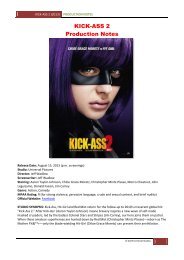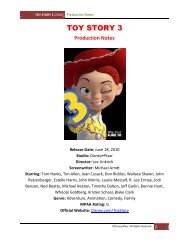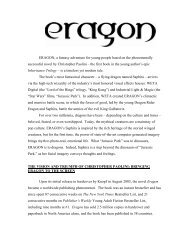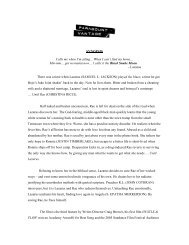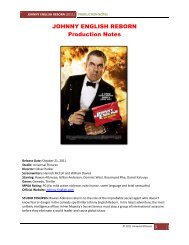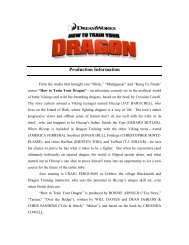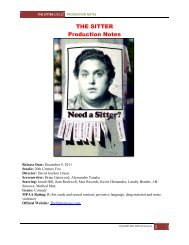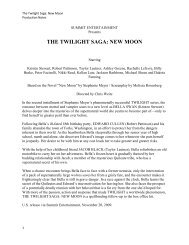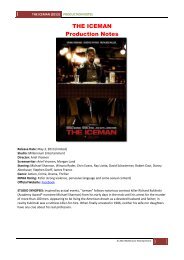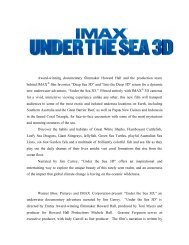FOX SEARCHLIGHT PICTURES Presents A VOLETTA ... - Thecia
FOX SEARCHLIGHT PICTURES Presents A VOLETTA ... - Thecia
FOX SEARCHLIGHT PICTURES Presents A VOLETTA ... - Thecia
You also want an ePaper? Increase the reach of your titles
YUMPU automatically turns print PDFs into web optimized ePapers that Google loves.
Not only did Coker have the benefit of having done more than five hours of one-on-one<br />
interviews with Wallace, he also, in the year’s following Biggie’s death, amassed dozens of<br />
conversations with many of the principal figures in Wallace’s life, including Voletta Wallace, Mark<br />
Pitts, Wayne Barrow, Faith Evans, James “Lil Cease” Lloyd, DJ Enuff, DJ Mister Cee, Sean “Puffy”<br />
Combs, Damien “D-Roc” Butler, and many of the other real life people featured in the film.<br />
All of this went into carving out a view of Biggie that melds each of the disparate elements of<br />
his life -- the rough code of the streets, his intimate relationships with family and friends and the<br />
transcendent power of his music – into a kaleidoscopic portrait.<br />
“Biggie was a genius at encapsulating entire moments of his life into a three and half minute<br />
song, and that’s the same trick I hoped to pull off in 119 pages as a screenwriter,” Coker says. “I wanted<br />
to pick vivid moments that would symbolize and summarize all the years of his life, and fit them all<br />
together visually the way Biggie did it musically for ‘Ready To Die’ or ‘Life After Death.’”<br />
Coker also had the advantage of being able to pull from stories that Wallace had confided to him<br />
during their interviews, adding subtle nuances and details to the screenplay. For example, Coker always<br />
loved the tale of how, in his lean early days, the rapper didn’t want his mother to know he was dealing<br />
drugs, so he would hide all of his designer clothes—the Izod and Le Tigre shirts, his jewelry and other<br />
spoils -- in a footlocker on the roof of his 226 St. James apartment building — and change into ‘fresh’<br />
clothes for Fulton street as soon as she wasn’t looking.<br />
“It’s just another little thing that makes it clear that Christopher Wallace and The Notorious<br />
B.I.G. were two completely different people,” Coker comments.<br />
Screenwriter Reggie Rock Bythewood, who penned Spike Lee’s critically acclaimed GET ON<br />
THE BUS as well as writing and directing DANCING IN SEPTEMBER and BIKER BOYZ, also came<br />
on board to deepen the character relationships, and add his own probing view into Biggie’s life,<br />
influence and appeal not only to hardcore hip-hop fans but to anyone who heard his full story.<br />
“I wanted to go against the grain of what is usually looked at when you make a movie about<br />
somebody’s life,” Bythewood explains. “The questions I wanted to ask were: what were his flaws as a<br />
human being How did all that feed into his music and the choices that he made”<br />
He continues: “I think what makes Christopher Wallace so interesting is that sometimes he<br />
seems to represent the worst of what people think about young black men; yet on another level, he<br />
symbolizes the best of young black men – as dutiful sons, attentive fathers, loyal friends. I hope the<br />
film’s exploration of that duality will challenge’s peoples perspectives – both on Christopher Wallace<br />
and on ourselves.”<br />
Both Coker and Bythewood ultimately came to see Wallace as a kind of chameleon who<br />
repeatedly and successfully changed colors, while trying to be all things to all kinds of people. Each of<br />
6




